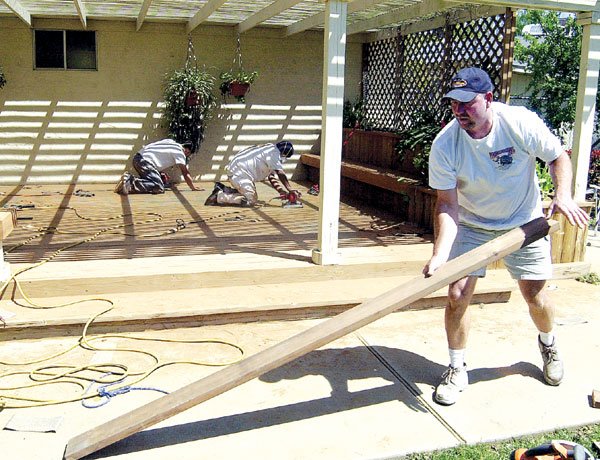The low thump of sandals on wood echoes through the back yard as
you step out to view the deck’s rich redwood finish, a sharply
appealing contrast to the green of the yard’s shrubs and trees. In
your mind, you see summer central
– barbecues, outdoor dinner parties, family get-togethers and
endless weekend hours of relaxation – but there’s work to do before
the fun can begin
The low thump of sandals on wood echoes through the back yard as you step out to view the deck’s rich redwood finish, a sharply appealing contrast to the green of the yard’s shrubs and trees. In your mind, you see summer central – barbecues, outdoor dinner parties, family get-togethers and endless weekend hours of relaxation – but there’s work to do before the fun can begin.
While a deck forms a beautiful, valuable addition to a home, maintenance is key to keeping that investment for years to come. The gleaming wood you put down this spring should last at least 15 to 20 years if properly laid and taken care of, but it will require an every-other-year investment of time and effort to stay looking so good, according to Brock Howard, a distributor for the Cade Corporation, a deck sealant company in San Jose.
Deck owners should start the spring with a good deck wash, according to Tim Collins, a painting contractor and deck restoration specialist who owns Personal Impressions painting in Gilroy. He recommends an oxalic acid wash, which should come packaged as “deck brightener.”
“Basically, what the wood cleaner is going to do is remove everything that’s happened during the year – stains, mildew, molds, dirt and things that have grown on the deck during the year – and brings it back to the surface underneath,” said Collins, who also recommends using the brightener to bleach out the stains caused by tannin bleed in redwood and cedar decking. These seepages of excess sap create dark, blackish stains that make wood look old and worn before its time, he said.
If a deck has not been sealed in the last 24 months, the deck brightener will also strip away any remaining sealer, said Collins, leaving the deck free for covering with a petroleum-based sealer, which penetrates and bonds with the wood rather than coating its exterior layer.
“Wood is organic, so if you’ve got a nice, porous material like wood, and it’s left in the sun, it’s going to absorb moisture,” said Collins. “That makes the wood expand and contract. You’re forcing the wood to split, and once it splits, it’s going to get weakened and more and more damaged. Then you’re at a point five, six, seven years down the road where you have to replace the deck.”
Petroleum-based products can create a clear seal that will last two to three years on a local property, according to Collins, who recommends a transparent seal as it is least likely to show scratches and wear spots created by pets and patio furniture.
For a longer-lasting, more colorful alternative to natural woods, Howard recommends a cementatious deck system, which is a top sealer made of Portland-based cement, or cement mix without any visible rocks. This powder is then mixed with powdered polymers and applied to create a seamless deck feature that will last for up to 10 years.
The deck coating can be applied in nearly any color, or even mixed to match the hue of a home’s exterior, according to Howard.
The result is a seamless surface that looks more like a permanent stone or concrete installation than a deck, and is capable of flexible movement – an especially helpful feature in areas with loose, shifting soil or histories of frequent earthquakes, he said.
Like regular concrete, cementatious decks offer homeowners the opportunity to create custom looks, like faux stonework and distinctive stains that look like tile. Products like Life Deck and Mercoat are in high demand right now for commercial installations, especially attractive to hotels and retailers for their durable, waterproof and inexpensive finishes that can be placed on everything from pedestrian walkways to pool decks, said Howard.
For either project, though, maintenance can only go so far. Making sure the deck you’ve dreamed of is well constructed is also key.
Homeowners should look for decking made of smooth, top-grade plywood in a one inch or three-quarter inch thickness that is free of any knotholes, said Howard.
Homeowners installing pre-made decks should be careful to follow manufacturer guidelines because each decking system is different, according to David Sowash, owner of Oasis Construction in Hollister.
Mounting decks on non-organic piers and creating enough spacing between boards to allow for ample air flow can be particularly important in keeping wood dry, according to deck builder Kim Katwijk, an Oregon-based deck builder who contributed an extensive article on rot-resistant decks to the April edition of the Journal of Light Construction.
Do-it-yourselfers should also attempt to limit collection zones for debris in order to cut down on rot.
This can be accomplished, wrote Katwijk, through simple design alterations such as spacing boards one quarter inch apart rather than the standard one-eighth, using solid four-by-six inch beams as girders rather than stacked two-by-four boards and mounting edging boards one inch under the lip of the deck rather than flush against the edge of the structure.
Caring for your investment makes that hollow sound so much sweeter, don’t you think?












